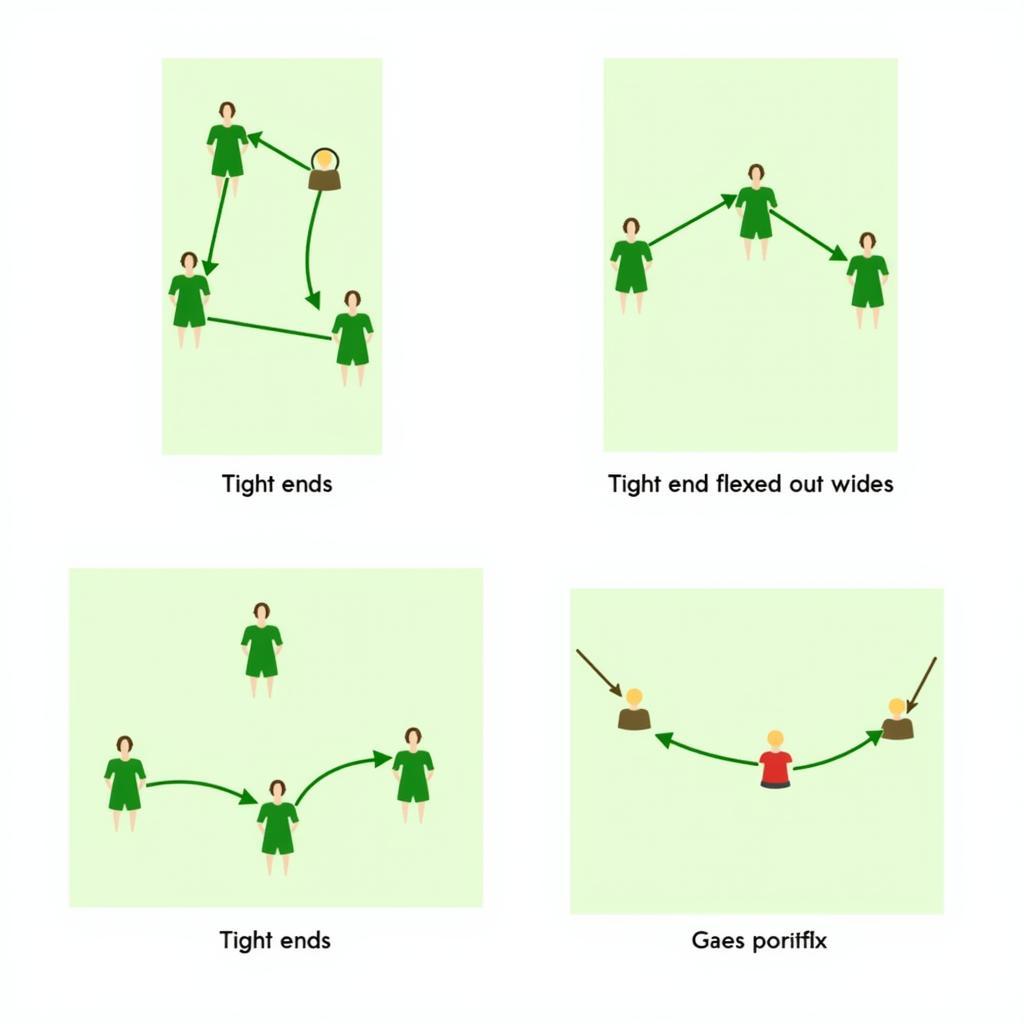The Double Tight Formation, a powerful offensive setup in football, is designed to create advantages in both the running and passing game. This formation can be a game-changer when employed effectively, leveraging the versatility of two tight ends. Let’s delve deeper into understanding this formation’s strengths, weaknesses, and strategic applications.
Similar to the strategies used in the bunch formation run plays, the double tight formation offers diverse options to outmaneuver the defense. It allows for greater flexibility in play-calling, keeping the defense guessing.
Decoding the Double Tight Formation
The double tight formation typically positions two tight ends on the same side of the offensive line, adjacent to the tackles. This creates a “strong” side, ideal for establishing a powerful running game. It also allows for effective play-action passing, as the tight ends can quickly transition from blocking to receiving routes.
While powerful, the double tight formation requires specific personnel and understanding. Teams need tight ends capable of both blocking effectively and running crisp routes. The offensive line must also maintain strong discipline, as the double tight side demands solid blocking technique to create opportunities.
Advantages of the Double Tight Formation
- Run Game Dominance: The extra blocker on one side makes the double tight formation particularly effective for power running plays.
- Play-Action Potential: The initial blocking setup can deceive the defense, opening up passing lanes after a fake handoff.
- Pass Protection: The two tight ends provide additional protection for the quarterback against blitzes.
- Versatility: The formation can be used to run inside, outside, or even pass plays, depending on the alignment and pre-snap motion.
Disadvantages of the Double Tight Formation
- Predictability: If used too often, the defense can anticipate run plays and adjust accordingly.
- Limited Spread: The formation naturally condenses the offense, potentially reducing the field available for passing plays.
- Personnel Requirements: Requires tight ends proficient in both blocking and receiving.
Variations of the Double Tight Formation
Several variations of the double tight formation exist, each with its own strengths. For instance, both tight ends can be flexed out wide, creating a more spread-out look suitable for passing plays. One tight end might also be aligned as a H-back, offering additional blocking support. The slot t formation shares some similarities with the double tight formation in terms of personnel and potential plays, showcasing the adaptability of these offensive strategies.
Maximizing the Double Tight Formation’s Potential
To effectively utilize the double tight formation, several factors need consideration. Proper personnel is crucial, as is having a diverse playbook that exploits the formation’s strengths. Pre-snap motion can also be beneficial, shifting the defense’s focus and creating advantageous matchups.
“The double tight formation is a valuable tool in any offensive coordinator’s arsenal,” says former NFL coach John Thompson. “Its effectiveness, however, relies heavily on proper execution and a well-defined strategy.”
When to Use the Double Tight Formation
The double tight formation is particularly useful in short-yardage situations, goal-line offenses, and when facing a strong defensive line. Its ability to establish a powerful run game also makes it suitable for controlling the clock and wearing down the opposing defense. Just like choosing between top players like Mark Andrews or Dallas Goedert, selecting the right formation depends on the specific match-up and game situation.
“A well-executed double tight formation can create nightmares for a defense,” states veteran NFL analyst, Mark Stevens. “Its versatility is key, allowing for adjustments based on the opponent’s weaknesses.”
 Double Tight Formation Variations
Double Tight Formation Variations
Conclusion
The double tight formation provides a potent offensive option, offering a balance between a strong running game and play-action passing potential. By understanding its strengths, weaknesses, and various applications, teams can leverage the double tight formation to create mismatches and dictate the pace of the game. Similar to deciding between Stefon Diggs or Cooper Kupp, choosing the right play from this formation can make all the difference in a game. Effective execution and strategic play calling are essential for maximizing its impact on the field.
FAQ
- What is the primary advantage of a double tight formation? Improved running game due to the extra blocker.
- What are some disadvantages of this formation? Can become predictable and limit the spread of the offense.
- What are some variations of the double tight formation? Flexing tight ends out wide or using an H-back alignment.
- When is the double tight formation most effective? Short-yardage situations, goal-line offenses, and against strong defensive lines.
- What kind of players are needed for a double tight formation? Tight ends who are good blockers and receivers.
- How can pre-snap motion help the double tight formation? It can shift the defense’s focus and create favorable matchups.
- Why is play-action effective from the double tight formation? The initial blocking setup can deceive the defense.
Looking for more insights into offensive strategies? Explore our articles on wing t formations and plays.
Need help? Contact us! Phone: 0902476650, Email: [email protected] or visit us at 139 Đ. Võ Văn Kiệt, Hoà Long, Bà Rịa, Bà Rịa – Vũng Tàu, Việt Nam. Our customer service is available 24/7.





